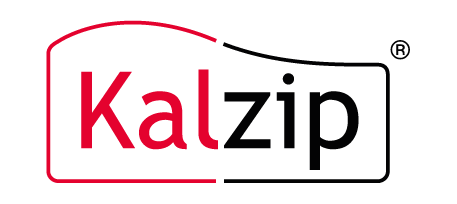ACOUSTIC PERFORMANCE IN SCHOOLS
/в News, Projects/от Yannick Gouder de Beauregard In contrast to many other sectors, there is detailed acoustic performance guidance for educational buildings. Here Adrian Whitefoot, Technical Services Manager at Kalzip, looks at the requirements of Building Bulletin 93 and how the correct specification of building envelope solutions can help achieve these.
In contrast to many other sectors, there is detailed acoustic performance guidance for educational buildings. Here Adrian Whitefoot, Technical Services Manager at Kalzip, looks at the requirements of Building Bulletin 93 and how the correct specification of building envelope solutions can help achieve these.
Ensuring good acoustics and minimising levels of noise in school environments is essential. A growing body of evidence has shown the impact of noise on academic performance and cognitive development. For example, a recent study from the Barcelona Institute for Global Health found that higher levels of traffic noise caused slower development in memory and attention among children aged 7 to 10.
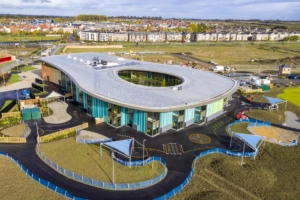
A quiet place for children gives the best surrounding for an ideal learning environment. (© KGM Roofing)
The main source of legislation for acoustics is Approved Document E of the Building Regulations, and in particular section E4, which specifically relates to acoustics in schools. For guidance on achieving the required acoustic conditions, Approved Document E refers to Building Bulletin 93 (BB93), the guide for acoustic design published by the Department for Education. While section E4 of the Building Regulations does not apply to colleges and universities, the acoustic recommendations provided in BB93 may also be desirable in these environments and therefore can provide a design standard.
Building Bulletin 93 sets limits for the level of ambient noise in rooms and spaces within a school based on how it is used. For example, the limit in classrooms and general teaching areas in primary and secondary schools, including those used for music and drama, is 35dB LAeq,30mins for new buildings and 40dB LAeq,30mins for refurbished buildings. Higher limits are set for sports halls, dance studios and swimming pools, while lower limits are given for teaching spaces for students with special hearing and communication needs.
Noise pollution can come from a wide range of sources, especially in school environments. External sources include aircraft, traffic, rain impact, noise from playgrounds and outdoor sports, and sound transmitted from nearby school buildings. Internally, impact and airborne sound from students and teaching activities can be transferred between floors and through walls.
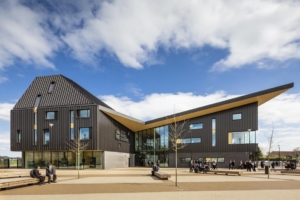 Noise reduction can be easily achieved with the use of the Kalzip Accoustic roof.
Noise reduction can be easily achieved with the use of the Kalzip Accoustic roof.
There are a number of measures that can be implemented in the specification of building envelope systems to improve the acoustic performance of both new build and refurbishment projects. Different insulation materials will have varying acoustic properties but one of the most effective methods for increasing sound insulation of roofing and facades is to increase the mass of the system. Its performance is governed by the ‘mass law’, which states that the sound insulation of a solid element will increase by approximately 5 dB per doubling of mass. With metal roofing systems this can be achieved by adding different densities and thicknesses of mineral wool or rigid slab insulation. Alternatively, for higher performance scenarios, various thicknesses of cementitious board can be introduced as part of the façade or roof build up. As a built-up solution, aluminium roofing and façade systems offer this flexibility to tailor the specification to meet the acoustic requirements.
In addition, acoustic and dampening membranes can also be used to increase sound insulation. For example, to reduce the sound of rain noise, an anti-drumming membrane can be bonded to the underside of an aluminium roofing system to achieve approximately a 6 dB reduction in sound intensity.
Controlling sound within teaching spaces must also be considered carefully when designing educational facilities. Excessive sound reverberation within a classroom can distort speech and make teaching and communication difficult. Building Bulletin 93 provides guidance on acceptable reverberation times (RT) depending on the intended use of the space. For example, for a new build nursery room or general purpose primary school classroom it is ≤ 0.6 seconds. In contrast, the same type of teaching space in a secondary school would only need to achieve a RT of ≤ 0.8 seconds. The correct specification of roofing and façade systems can help to minimise excessive reverberation as well. Perforated liners and structural decks can be introduced as part of the roof build-up to diffuse sound where improved sound absorption performance is required.
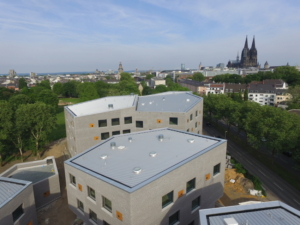
The Kalzip Accoustic roof is based on the proven Kalzip technology with the same flexibility.
Achieving the optimum specification to ensure acoustic targets are met alongside all other building performance and design requirements can be complex. That is why it is important to partner with a roofing and façade system manufacturer that can offer a wide array of solutions as well as technical support services. Leading manufacturers, such as Kalzip, will be able to use laboratory test reports and data from previous projects to provide specification guidance and assess the performance of a proposed system.
Ensuring the acoustic performance of school buildings is essential to provide an environment that supports learning and development. Building Bulletin 93 provides detailed guidelines, which the correct specification of building envelope materials and systems can help achieve.
Kalzip: Focus on online presence
/в News, Unternehmensinformationen/от Yannick Gouder de BeauregardThe expansion of the digital strategy not only pays off for Kalzip in terms of customer growth, but also increases awareness among existing customers. For personal loyalty, the company also relies on its proven premium partner network.
«From our point of view, the following points are relevant for a trade fair appearance: Increasing brand awareness, acquiring new customers, maintaining existing customers, and obtaining project information. By revising our digital strategy, we were able to noticeably improve the perception of the Kalzip brand on the market. Not least due to the challenges of the last few years, digital media have become so established that we can report clearly measurable successes. Kalzip has also been cultivating its network of premium partners for many years in order to maintain personal ties with existing customers. We currently use various digital channels for project acquisition. Due to these successes, as well as the continuing imponderability of a trade fair with a presence in the near future, we have decided not to participate as an exhibitor at the BAU 2023 trade fair in Munich», announces Christoph Schmidt, Sales Manager Kalzip. «Together with the installers from our globally active network, we are tackling the challenges of our time, developing solutions, and pursuing joint further developments,» Schmidt continues.
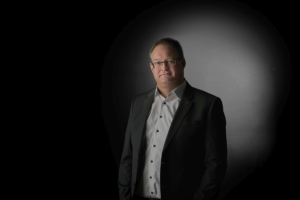 Christoph Schmidt, Sales Manager Kalzip. (Photo: Kalzip GmbH)
Christoph Schmidt, Sales Manager Kalzip. (Photo: Kalzip GmbH)
For the time being, Kalzip wants to continue to focus on its successful digital concept. In the first half of 2022, the Koblenz-based company already received the German Brand Award for the «Digital Brand of the Year». «The award is confirmation for us that we are already implementing many things correctly in order to be perceived on the web and thus also on the market. We are therefore focusing our communication on further expanding our digital strategy in order to reach existing and potential new customers,» says Yannick de Beauregard, Marketing Manager at Kalzip. «Furthermore, we see ourselves well equipped for the challenges of the near future, also in terms of products. With our roof solutions, which can incorporate photovoltaics or a natural roof, as well as with our award-winning refurbishment system, we contribute to sustainable construction.»
 Yannick de Beauregard, Marketing Manager Kalzip. (Photo: Kalzip GmbH)
Yannick de Beauregard, Marketing Manager Kalzip. (Photo: Kalzip GmbH)
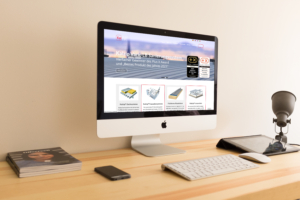 Visibility on the web: The Koblenz-based company Kalzip is focusing on further expanding its digital strategy.
Visibility on the web: The Koblenz-based company Kalzip is focusing on further expanding its digital strategy.
Publisher:
Kalzip GmbH
Press contact: Yannick de Beauregard
August-Horch-Str. 20 – 22
56070 Koblenz
Tel: +49 261 9834 217
Mail: Yannick.Gouder-de-Beauregard@kalzip.com
About Kalzip
Kalzip is one of the leading suppliers of roofs, façades and building envelopes made of aluminium and metal. The company has been producing roof and façade systems on state-of-the-art roll forming lines since 1968. To date, over 110 million square metres of Kalzip profiled aluminium sheets have been installed worldwide, and the trend is constantly rising. Kalzip is represented internationally by numerous sales offices and a globally available fleet of mobile production units.
Kalzip aluminium building systems meet the highest building physics and design requirements for roofs and façades that are both functional and visually impressive.
KALZIP – „Pavilion Scheveningen“
/в News, Projects/от Leon Schmitz EUWArchitecture on the Scheveningen waterfront
The Vision.
Scheveningen is an internationally known vacation destination and not only the largest but also the best frequented seaside resort of the Netherlands. Its endless beaches and the spectacular redesign of the beach boulevard in 2015 make this town worth a visit throughout the year. At this special place, the Dutch architect Wim de Bruijn has designed a unique pavilion, whose design and functionality has no equal. It opened to the public in 2021.
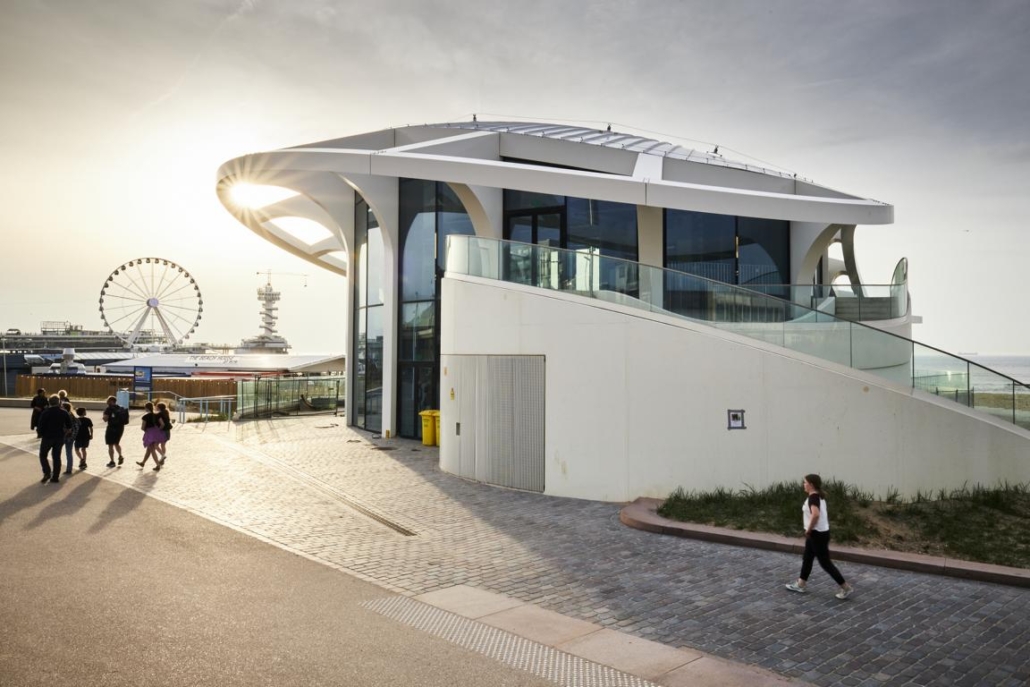
The impressive building at the end of Noordboulevard’s beachfront combines ‘the elegant shapes of the Morales-Boulevard with waves and shells at the beach, all together frozen still in a white composition of glass and steel’ describes de Bruijn of the new boulevard’s icon. At first, the roof shape of the wire frame model seemed to be impossible to construct but perfect teamwork by many different specialists made it possible.
Engineering:
The foundation of the exceptional 3D-shaped roof construction is Kalzip’s X-tail profile sheet. A vertically adjustable pipe construction made it possible to follow the designated contours of the standing seam roof cladding. This led to all the profiled sheets having different measurements, so the experts on site had to follow a strict installation plan which was provided by Kalzip. The steel substructure of the standing seam roof cladding prevents noise pollution from penetrating outwards and adapts to the wind movement on site
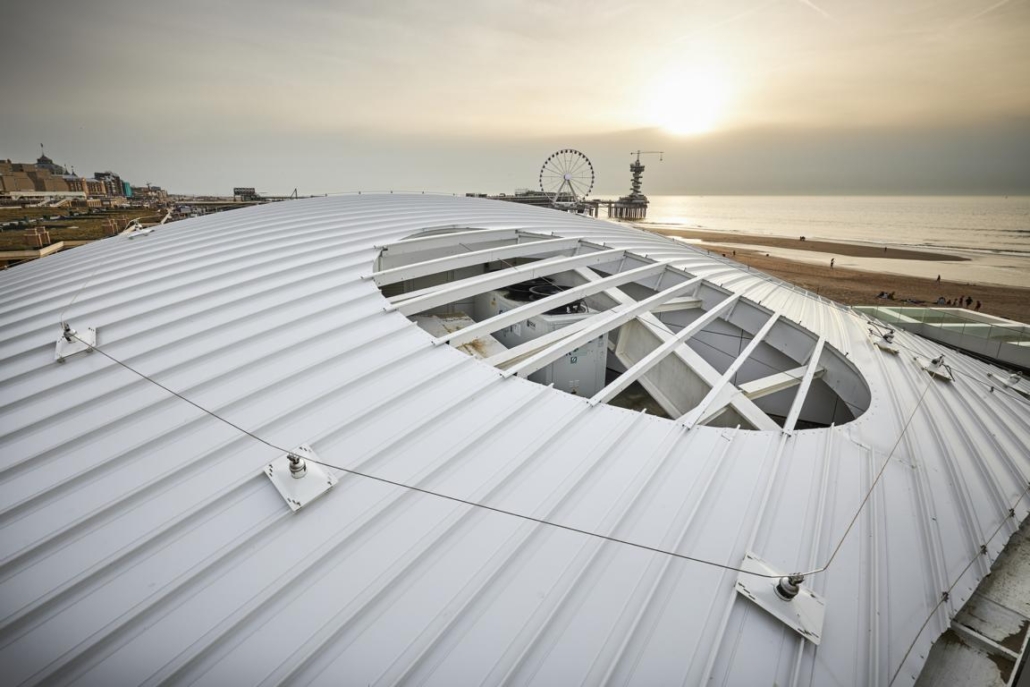
That was a very important subject to consider beforehand, since the pavilion is located precisely at the noise location of beachfront and boulevard (from stone to dune). The spectacular round shape and the aluminum roof cladding make this building an impressive eyecatcher from every direction.
Sustainability:
The three-storey building consists of a basement, a main floor with a terrace and a first floor with another huge terrace, that had to be ‘cut off’ the main roof to gain an exclusive elevated view onto the beach and the boulevard. But not only from the terrace you can enjoy the spectacular view, also through the insulated glass windows from the interior of the house, the beach feels as close as it gets. Daylight illuminates the main floor almost self-sustaining and contributes to the fulfilment of de Bruijn’s vision.
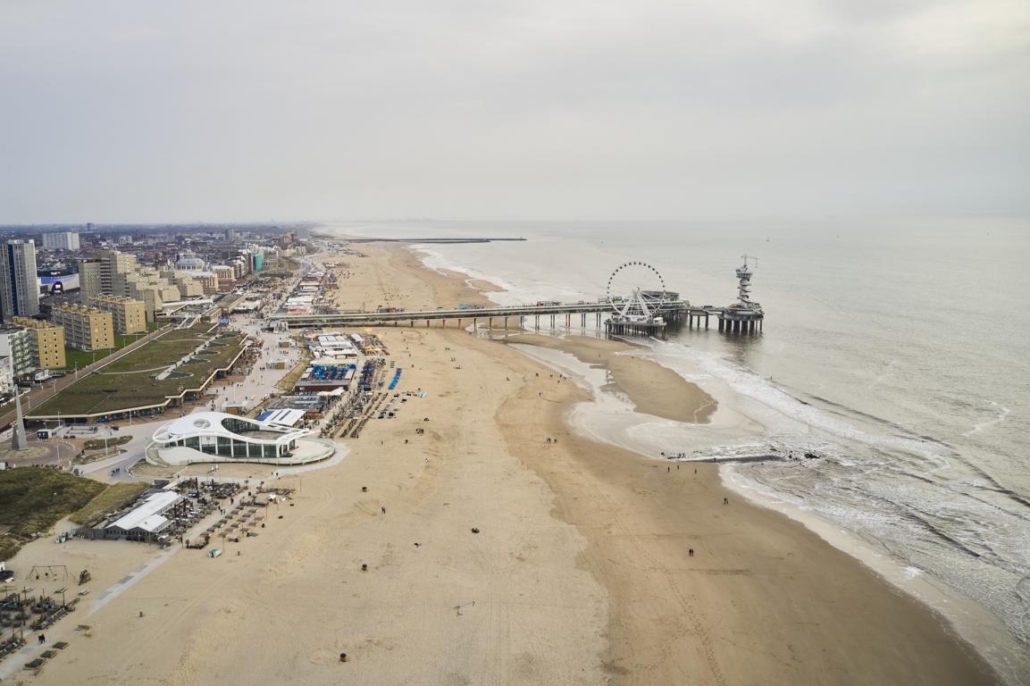
The pavilion has an excellent thermal insulation value (U-value=6), based on the combination of PIR and fiberglass systems that were used insulating the roof construction. The long-lasting aluminum consists almost fully of recycled materials and classifies as sustainable metal. The Noordboulevard covers most of its energy demand per solar panels which are also connected to the pavilion.
Teamwork:
To make de Bruijn’s vision a reality, the technical crew, Felspartner B.V. (Kalzip PremiumPartner) and Kalzip had to work as a synchronized team from the very beginning. It was crucial, that every specialist could bring in his experience as they began working with 3D models. A construction site at beachfront always brings its own challenges that could only be handled with a perfectly organized and well attuned team of experts. Teamwork, combined with skilled craftsmanship and communication at eye level led to an innovative and sustainable building, that blends in in its sensitive surroundings, connecting the elements of ocean, beach and water trough state of the art architecture and efficiency.

Kalzip – There’s no way to do it better.
Contact
Kalzip GmbH
Yannick de Beauregard
Kalzip Marketing
August-Horch-Str. 20 — 22
56070 Koblenz
Phone: +49 261 9834 0
Fax: +49 261 9834 100
E-Mail: yannick.de-beauregard@kalzip.com
Sustainable production halls at TRUMPF
/в News, Projects/от Kalzip GmbH NewsNew buildings on the company premises of TRUMPF near Stuttgart:
Industrial buildings as electricity supplier
Large module for small technology. This was the theme of Kalzip’s involvement in the completion of the Trumpf manufacturing halls in Ditzingen. Three halls were fitted with Kalzip roofs, which combine a modern design with an integrated solar roof solution.
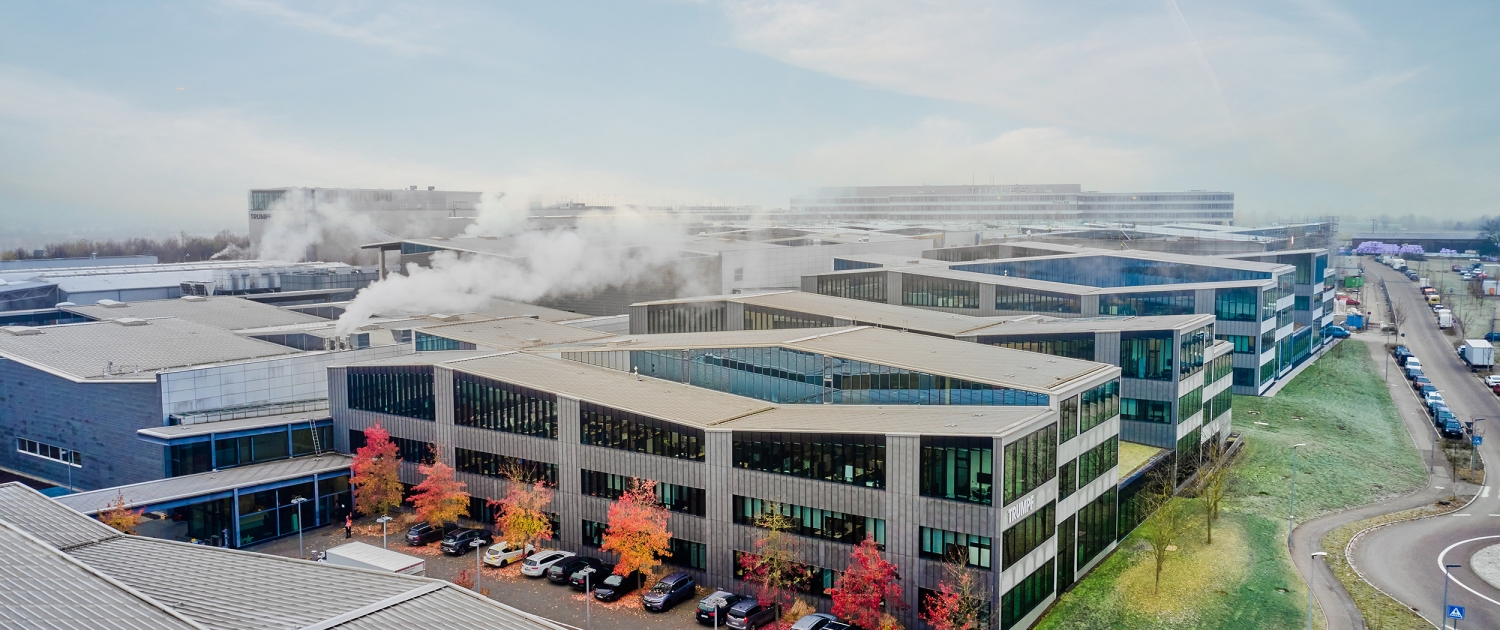 The company premises of TRUMPF in Ditzingen near Stuttgart
The company premises of TRUMPF in Ditzingen near Stuttgart
Playing with angles and heights
TRUMPF has been providing ready-made solutions in the fields of machine tools, laser technology, electronics, and power tools for almost 100 years. The architectural firm Barkow Leibinger from Berlin provided the design for the newly constructed buildings. Instead of the usual simple flat roofs, the architects opted for dynamic-looking roof construction. Slightly pitched gable roofs and butterfly roofs with slopes of 5° each alternate three to four times per hall and form a straight line at the ridge and eaves when viewed from above.
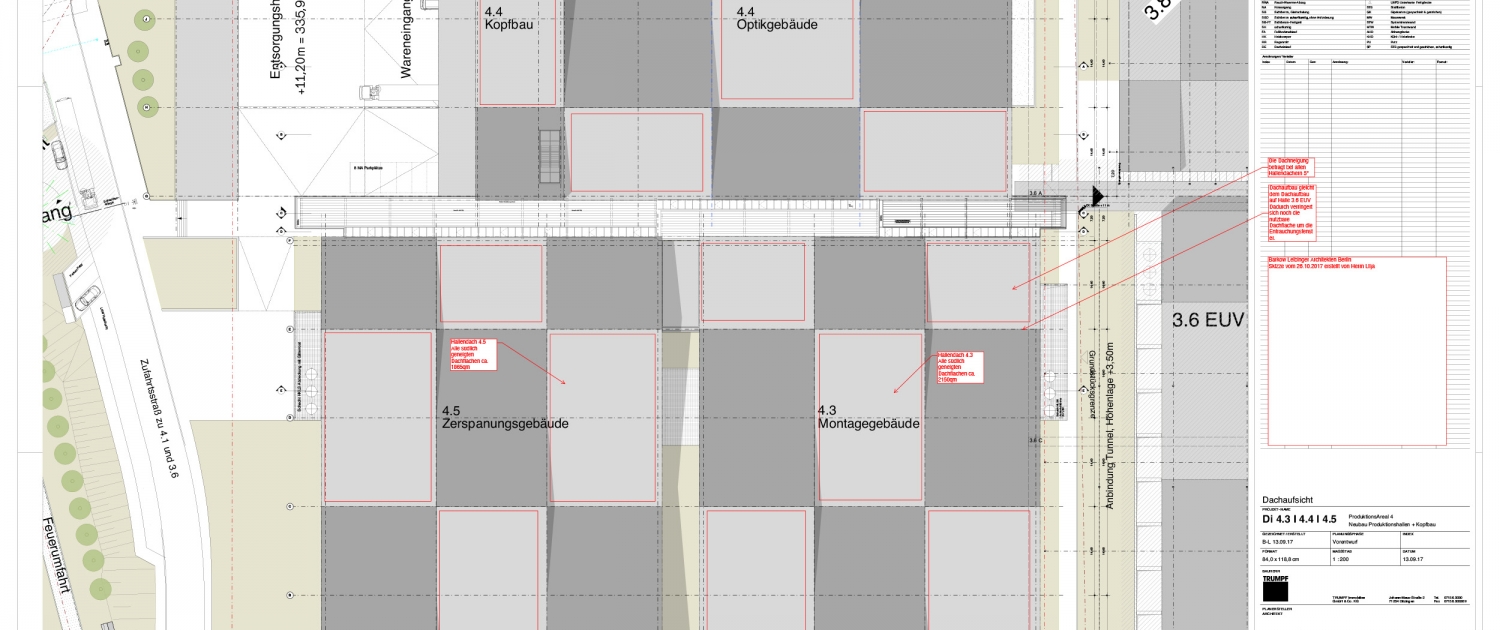 The design from the Architekturgesellschaft Barkow Leibinger is playing with contrary angles
The design from the Architekturgesellschaft Barkow Leibinger is playing with contrary angles
Active use of roof space
In addition, Kalzip contributed to a special feature with its roofing components. In contrast to other manufacturing halls, the new buildings in Ditzingen were largely covered with solar panels, which contribute to sustainable energy generation. The architects’ desire to achieve the highest possible utilisation of solar modules with a homogeneous surface area presented both the manufacturer Kalzip and the fabricators with challenges.
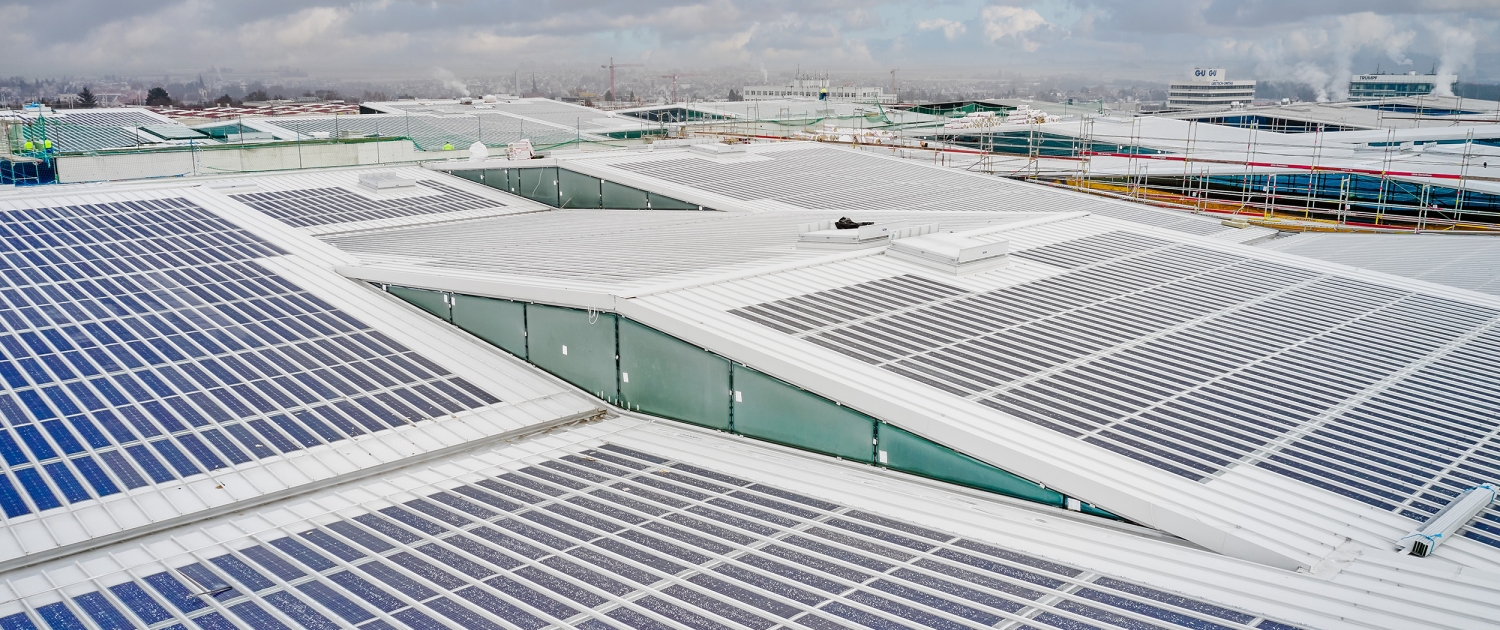 Appearance and function are going hand in hand
Appearance and function are going hand in hand
Practical challenges in transport and assembly
A further challenge was the special production in excess length. For the building project in Ditzingen, profiled sheets with a length of up to 28 metres and with up to 12 solar modules on one profile were created — making them the largest AluPlusSolar profiled sheets ever produced and delivered by Kalzip. The transport was correspondingly difficult: loaded onto an overlength lorry, the profiled sheets were permanently kept under surveillance by an escort vehicle belonging to the haulage company. In addition, a police escort accompanied the lorry on the route from the Kalzip plant in Koblenz via the motorway to the construction site in Ditzingen. Kalzip profiled sheets were installed as the final layer. Due to roof permeations and transitions, the sheets were produced in different lengths accordingly.
To be able to connect the solar modules and with the inverter, the fitters had to install each panel individually, which required a special effort from the team: «We have installed Kalzip systems before, but never on this scale. Placed on the standing seam of the previous profiled panel, around 11 installers had to hold the panel at an angle so that the electrician could connect the wires underneath,» explains Tobias Brohmann.
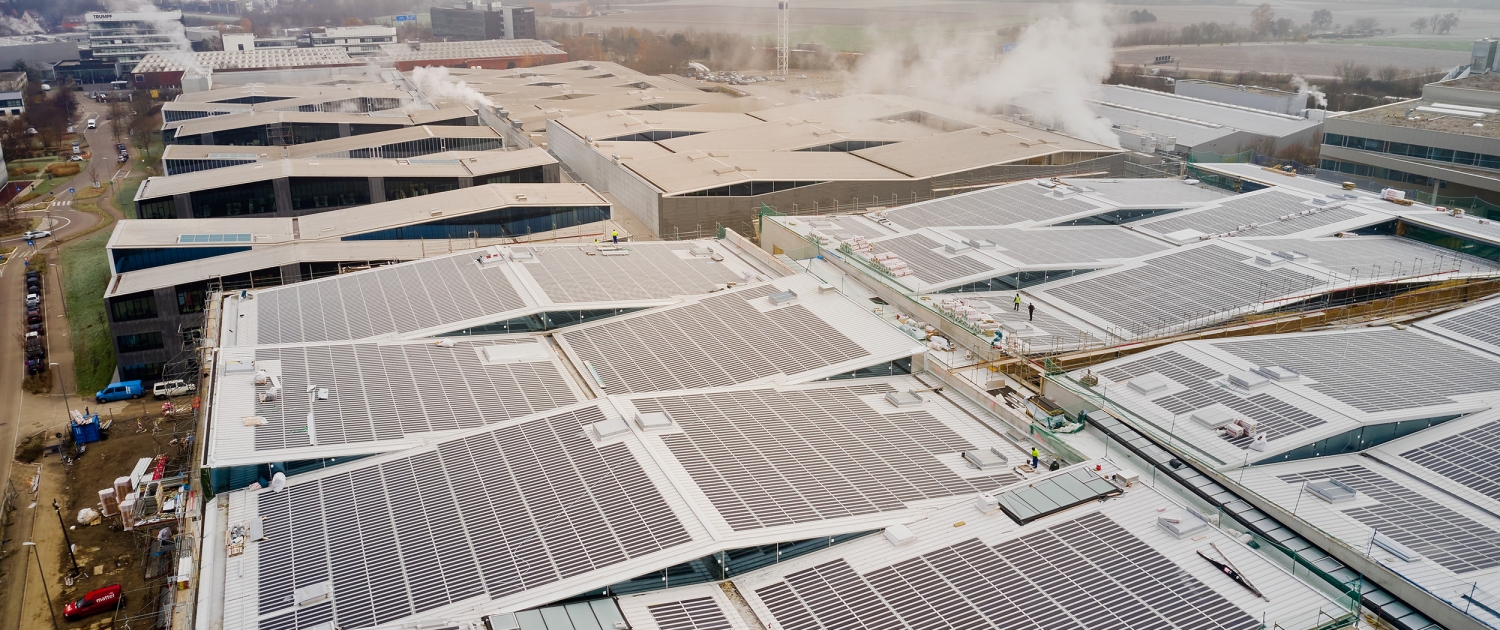 The dimension of the solar modules as a challenge on the construction side
The dimension of the solar modules as a challenge on the construction side
Enough electricity for a whole village
But all the hard work paid off. The highest possible utilisation of solar panels was achieved. Except for a few centimetres of edge strips and at roof intersections, solar panels have been installed on the roof surfaces of a total of about 15,200 m2 over the entire area. A total of around 10,000 panels achieve an output of 1,138.5 kWp — an amount of energy to supply 100 one-family houses with electricity — and thus ensure sustainable and ecological energy generation.
About Kalzip
Kalzip sells and produces aluminium roof facade profiles for the areas of industrial construction, leisure facilities/sports facilities, transport and housing. The Kalzip Group employs 160 people worldwide and is represented in almost all regions of the world. Since October 2018, Kalzip has been a company of the Donges Group. Donges Group is a leading supplier of bridge and steel construction as well as roof and facade systems in Europe. The group consists of the brands Donges SteelTec GmbH, Flachdach- Technologie GmbH & Co. KG, Kalzip GmbH, Nordec OY and Norsilk SAS and employs around 1400 people in 14 countries.
Contact
Kalzip GmbH
Yannick de Beauregard
Kalzip Marketing
August-Horch-Str. 20 – 22
56070 Koblenz
Phone: +49 261 9834 0
Fax: +49 261 9834 100
E-Mail: yannick.de-beauregard@kalzip.com
Futurebuild 2022 in London
/в News, Veranstaltungen/от Kalzip GmbH NewsKalzip is proud to announce, that we will exhibit together with BIPVco at this year’s Futurebuild event, taking place from 01-03 March 2022 in London. Both companies are a perfect match for Futurebuild because they both have been focusing on sustainability for a long time and so has Futurebuild. Kalzip has been working on its sustainability processes for nearly 60 years.
Talking about the future
Around 20,000+ decision-makers and disruptors are expected to attend, each and everyone looking forward to finding new products and solutions for their businesses. Futurebuild 2022 will be featuring manufacturers and suppliers of the most innovative technologies, displaying the newest products and services from the built environment. The high-profile panels will be held by influential thought leaders and pioneering thinkers talking about the industry’s most relevant issues.
For Kalzip and BIPVco, it’s the perfect opportunity to share their processes, innovations, and solutions with thousands of industry influencers and shapers. Futurebuild 2022 is divided into six sections, providing you with innovative solutions that are addressing the biggest challenges facing the built environment.
These sections are: Buildings, Energy, Critical Infrastructure, Interiors, Offsite and Resourceful Materials.
Solutions for a sustainable energy household
Kalzip’s and BIPVco’s stand C43 will be located in the energy section, which fits perfectly because both companies have been working on the sustainability topics net-zero carbon processes and photovoltaic roofing solutions for many years. Bringing the products of both together, with Kalzip AluPlusSolar a wide range of roof shapes can be achieved. Barrel duo or monopitch roofs can be designed as energy roofs just as easily as individually curved shapes. Kalzip AluPlusSolar can also be used for the entire building envelope and facade surfaces. Kalzip offers architects planning possibilities for designing solar living spaces in an environmentally conscious manner – economically, sustainably and aesthetically.

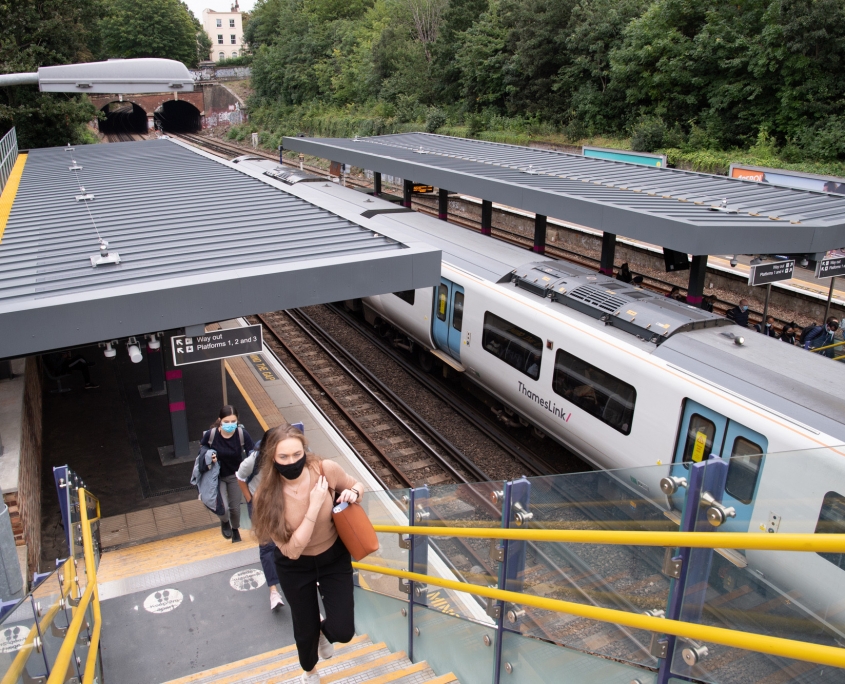
Highly complex bent surfaces or public building projects with high standards in longevity: Kalzip & BIPVco can handle every challenge. Read more about the product
Visit us at Futurebuild and register now!
About Kalzip
Kalzip sells and produces aluminium roof facade profiles for the areas of industrial construction, leisure facilities/sports facilities, transport and housing. The Kalzip Group employs 160 people worldwide and is represented in almost all regions of the world. Since October 2018, Kalzip has been a company of the Donges Group. Donges Group is a leading supplier of bridge and steel construction as well as roof and facade systems in Europe. The group consists of the brands Donges SteelTec GmbH, Flachdach- Technologie GmbH & Co. KG, Kalzip GmbH, Nordec OY and Norsilk SAS and employs around 1400 people in 14 countries.
Contact
Kalzip GmbH
Yannick de Beauregard
Kalzip Marketing
August-Horch-Str. 20 – 22
56070 Koblenz
Phone: +49 261 9834 0
Fax: +49 261 9834 100
E-Mail: yannick.de-beauregard@kalzip.com
Building of the Ajman-Kadyrow-Mosque
/в News, Projects/от Kalzip GmbH NewsThe Ajman-Kadyrow-Mosque in Chenya:
Russias most modern Mosque
Kalzip solves structural challenges
In May 2014, the Ajman Kadyrov Mosque in the city of Argun in Chechnya was ceremoniously opened. Kalzip also contributed to this celebration with its roof structures in high dimensions. The Ajman Kadyrov Mosque, also known as «Mother Heart», is considered Russia’s first ultra-modern mosque.

The building site in Argun had enormous challenges for the construction to overcome
Traditional components, new interpretations
The architecture of the building is particularly striking: Instead of the classic square ground plan with dome and imperial spires, the mosque designed by the Turkish architect Deniz Jeyhun Baikan uses a modern formal language. The roof forms a hemisphere that appears to rise from the ground when viewed from the main entrance. Three other sides let daylight into the interior through large glass fronts and at the same time connect the main building with the three minarets.
In order to realise the architect’s visions, a well thought-out plan was needed. The special geometry of the building had to be taken into account, which led to an unsatisfactory result in the first attempt at a solution. The ornaments were to be projected onto the dome. Due to the geometry of the building, the model would have run in different places and been unrecognisable as such from the viewer’s perspective. But equipped with the appropriate software, Kalzip was first able to calculate a surface from the measurement of the roof from around 2,000 points, reflecting the points on the convex dome. The ornamental model was then transferred from the existing image file onto the surface created in this graphic and aligned in such a way that no distortions were created. In addition, the model enabled the necessary material to be prefabricated and delivered at the Kalzip factory in Koblenz for an exact fit.

The complex 3D-visualization of the dome surface with ornaments
From Rendering to implementation
To ensure a satisfactory result, some construction challenges had to be managed. For example, the unevenness of the concrete dome was levelled out to allow the use of Kalzip’s Flexikon substructure. The visible layer under the ornaments was laid with flat sheets from Kalzip, which were already coated in the factory with a «copper antique» colour.

Assembling of the gold-colored ornaments with substructure on the laid flat sheets
Golden by day — colourful by night
Thanks to the complex construction, the oriental ornamentation is particularly effective regardless of the time of day. The gold-anodised aluminium panels with a matt surface gently reflect the daylight and invite visitors to linger. With the concealed LED lighting, the roof is illuminated at night underneath the ornaments in different colours, enhancing the three-dimensional effect. The heating system, which is also invisible, ensures unrestricted operation even in the cold winter months and avoids damage from sliding snow.

The LED-illuminated Ajman Kadyrov Mosque in the evening mood
About Kalzip
Kalzip sells and produces aluminium roof facade profiles for the areas of industrial construction, leisure facilities/sports facilities, transport and housing. The Kalzip Group employs 160 people worldwide and is represented in almost all regions of the world. Since October 2018, Kalzip has been a company of the Donges Group. Donges Group is a leading supplier of bridge and steel construction as well as roof and facade systems in Europe. The group consists of the brands Donges SteelTec GmbH, Flachdach- Technologie GmbH & Co. KG, Kalzip GmbH, Nordec OY and Norsilk SAS and employs around 1400 people in 14 countries.
Contact
Kalzip GmbH
Yannick de Beauregard
Kalzip Marketing
August-Horch-Str. 20 — 22
56070 Koblenz
Phone: +49 261 9834 0
Fax: +49 261 9834 100
E-Mail: yannick.de-beauregard@kalzip.com
Changes in the management of Kalzip GmbH
/в News, Unternehmensinformationen/от Kalzip GmbH NewsKalzip is reorganising its management and appointing Andrew Leach to the management board alongside Peter Brechtelsbauer from 1 December 2021.
As of 01 December 2021, Andrew Leach will lead the company as CEO. In this new role, he will be supported by his colleagues in the management team. At the same time, Mr. Frank Krauskopf will resign as Managing Director of Kalzip, so that in future Andrew Leach and Peter Brechtelsbauer will act jointly as the general management of Kalzip GmbH.
Andrew Leach has known both Kalzip and the industry for many years. He has held numerous management positions in sales and marketing at international level and is therefore ideally equipped to take on the responsibility of CEO. The further development of the international business and the strengthening of synergy effects within the Donges Group will also be a focus of his responsibilities.
Peter Brechtelsbauer and the management team in Koblenz are very pleased that Andrew Leach is taking on this responsible task and wish him all the best in his new role.
About Kalzip
Kalzip is an international manufacturer of aluminium roof and facade systems. Producing in Germany, the company has a distribution network in Great Britain, France, Spain, Dubai, and India. Kalzip produces on modern, partly mobile roll-forming lines and can therefore offer high-quality, customer-specific roof systems for stadiums, sports halls, traffic structures, industrial buildings, commercial buildings, and residential areas. Kalzip provides a comprehensive range of products for both new buildings and renovation projects.
Kalzip has been a company of the Donges Group, the leading supplier of bridges, steel constructions, roof and façade systems in Europe, since 2018. The Group, employing 1300 people worldwide, has the companies Donges SteelTec GmbH, FDT Flachdach Technologie GmbH, Kalzip GmbH, NORDEC OY, and Norsilk SAS under its roof.
The new building of Tenerife Airport has a Kalzip Standing seam roof
/в News, Projects/от Kalzip GmbH NewsThe Tenerife South Airport’s connection building is expected to increase the airport’s size by 50 per cent
In 2018 the Government of Tenerife decide to extend the Island’s Airport. For the amount of 53,9 million euros the new connection building was planned with Casadevall & Sayeras arquitectes commissioned to design the building. The new building will house, as a priority, security control filters and provide continuity from the gates to boarding lounges and the departure and arrival halls.
Kalzip is the specialist for airport roofs
In the past, architects have repeatedly relied on Kalzip for the planning of airport roofs. As a result, a certain know-how has developed at Kalzip over the years. This know-how was the key to success when it came to the tender for Tenerife Airport.
The curved roof, which shelters the entire interior space, is the main element of the project. It is composed of curved lattice beams and a light deck-type slab, complemented by the metallic finish of the roof based on aluminium standing seam Kalzip system, with a low reflective patina finish surface. The build-up utilises a double layer of rock wool insulation and Kalzip polyamide E clips to provide thermal and acoustic properties according to the project specification.
In the end over 11,750 sqm of Kalzip 65/333 in Kalzip AluPlusPatina Nature mill finish surface were installed on the new junction building.
Special design for a Junction Building
“We do not know of another passenger terminal in which a new ad hoc building has been designed basically to contain the security controls. We are talking about approximate dimensions of 150 meters long by 95 deep. Our proposal aims, by means of a soft design «gesture», to encompass, cover, the entirety of the new space. We achieve this with an arc segment with a circumference of radius 150 meters. With this formal strategy, the façade surface is minimized, which we envisage entirely glazed. Thus, from the new departure lounges and the adjacent circulation space, it is possible to continue enjoying the marvellous maritime profile.” Said Dolors Sayeras, one of the projects leading architects.
Linear transverse skylights emphasize the curved character of the roof and direct passengers in their transit from the ground side to the air side, achieving a diaphanous and light interior space, diffusing the light evenly thanks to a semi-white and white false ceiling permeable to vision.
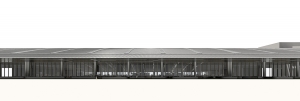
3D visual of the planned junction building. © Casadevall & Sayeras arquitectes.
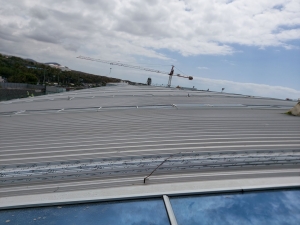
Photo of the construction phase – The Kalzip sheets have already been installed.
About Kalzip
Kalzip is an international manufacturer of aluminium roof and facade systems. Producing in Germany, the company has a distribution network in Great Britain, France, Spain, Dubai, and India. Kalzip produces on modern, partly mobile roll-forming lines and can therefore offer high-quality, customer-specific roof systems for stadiums, sports halls, traffic structures, industrial buildings, commercial buildings, and residential areas. Kalzip provides a comprehensive range of products for both new buildings and renovation projects.
Kalzip has been a company of the Donges Group, the leading supplier of bridges, steel constructions, roof and façade systems in Europe, since 2018. The Group, employing 1300 people worldwide, has the companies Donges SteelTec GmbH, FDT Flachdach Technologie GmbH, Kalzip GmbH, NORDEC OY, and Norsilk SAS under its roof.
Contact
Kalzip GmbH
Yannick de Beauregard
August-Horch-Str. 20 — 22
56070 Koblenz
Phone: +49 261 9834 0
Fax: +49 261 9834 100
E-Mail: yannick.de-beauregard@kalzip.com
Integrated PV Solution powered by Kalzip
/в News, Projects/от Kalzip GmbH NewsInnovative Solar building techniques for a new facility building at Prestwick
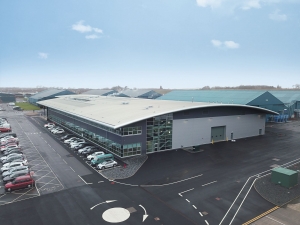
The bonded solution is streamlined to the roof and allows you to read the building form.
The creation of an important new research facility at Prestwick in Scotland has included the largest installation to date of the innovative new AluPlusSolar system developed by Kalzip®, with the photovoltaics being integrated into the manufacturer’s standing seam roof by one of its longest established Teamkal contractors.
The 8,000 m2 building was designed by Glasgow-based Hypostyle Architects with Balfour Beatty appointed as main contractor. Fowler McKenzie, which operates across the whole of Scotland from its premises in Aberdeen, is the roofing and cladding specialist which undertook the entire envelope package and was responsible for putting Kalzip AluPlusSolar forward to the project team.
AluPlusSolar is a versatile and highly energy efficient lightweight system that has been developed in conjunction with BIPVco who supplied the panels for bonding onto the Kalzip® 65/400 roof sheets. The latter were rolled to length on site for Fowler McKenzie’s teams to install directly across the full span of the barrel-vaulted structure. Crucially, the super thin PV laminate and connected equipment add just 3 Kg/m2 to the weight of the roof: a total saving of 8.5 tonnes across the development compared to standard systems – while providing a potential peak capacity of 126 kWp.
Fowler McKenzie has installed many Kalzip roofs in the past
The Managing Director of Fowler McKenzie, Phil McKenzie, commented: “Going back almost 20 years, we are the longest established member of Teamkal in Scotland and have been installing Kalzip® systems from well before that. This, however, was our first experience of installing the new Kalzip AluPlusSolar, and our first contract for Balfour Beatty in the Central Belt, as opposed to our work for them around Aberdeen.
“When we tendered for the contract, with Kalzip® 65/400 already specified, it was envisaged to install conventional PV panels over the top, but we suggested the use of Kalzip® AluPlusSolar as an alternative which we were aware would offer time and cost savings. It consequently delivered an 8.5 tonne weight saving across the whole building.”
Kalzip AluPlusSolar is made for flexible architectural requirements
The Kalzip AluPlusSolar profile can be produced in the full range of RAL colours as well as a variety of forms, including concave and convex to suit a wide variety of roof structures. Also being integrated and low in weight, they therefore offer architects and engineers greater flexibility compared to conventional PV arrays while delivering similar power output. With very low future maintenance implications, this all results in a far lower whole-life cost for a development.
The Commercial Director of BIPVco, Justin Canning explained: “Our laminates are very light and only a few millimetres thick, making them fully flexible; With conventional solar panels that are installed on a frame above the roof covering, there is the potential for wind load to cause damage – our panel is bonded direct to the roof so there are no gaps between the roof and the solar panel.”
Looking to the future, Justin added: “I’m very excited about our partnership with Kalzip® and very happy to have this significant project completed. This is a truly innovative approach to putting photovoltaics onto a commercial roof and is testament to the on-going collaboration between Kalzip® and BIPVco – the 2021 pipeline is looking very strong and we are working on projects around the globe.
“Architects love the fact there is no effect on the roof’s aesthetic, and there is far less maintenance during the life of the roof: the module is self-cleaning due to an outer layer of ETFE and this means we need far less access equipment for maintenance. We foresee many more jobs on industrial buildings, sports stadia and other structures including residential and modular.”
The Associate at Hypostyle Architects dealing with the project, Steven Colvin, confirmed the positive implications for designers and other specifiers. He said: “The contrast between AluPlusSolar and other PV systems is vividly illustrated by the adjoining building at Prestwick, which we also designed with a Kalzip® roof that has the PV mounted on triangular assemblies — because of the roof angle — plus all the associated access walkways.
“Instead the bonded solution is streamlined to the roof so that you don’t really see it from the ground, and it allows you to just read the building form; while the client was very keen on the greatly reduced maintenance implications. Kalzip AluPlusSolar even rules out problems such as birds nesting under panels, and there are no shadows cast by them being lifted up – which can reduce the efficiency.”
The Project Manager for Balfour Beatty, Tony McKay also identified potential programme benefits to AluPlusSolar for future developments. He reflected: “Balfour Beatty in conjunction with Fowler McKenzie, Kalzip® and Hypostyle identified the benefits of the new PV system during the early roof build up design development phase.
“The Kalzip® solution has taken a considerable loading off the roof and reduces maintenance as we are only installing one product in lieu of a traditional PV panel and a walkway product. Aesthetically it also provides a better finish to the build. It also reduces the number of trades on the roof, which assists health and safety and reduces the likelihood of damage to the finished Kalzip sheet.
“The incorporation of this product into the design at a concept stage will allow further potential benefits to be realised. If incorporated early enough, it could reduce the structural steel section sizes and roof purlin section sizes and centres, which would reduce material costs and install time. This should be a focus for future projects.
“Balfour Beatty have a long history of works at Prestwick dating back to the 80’s, with more recent projects which I was involved with including the Bristow Helicopter Search and Rescue Hangar, also including a Kalzip® roof and cladding. Aesthetically the AIC building with the Kalzip® roof and AluPlusSolar is the most impressive.
The BIPVco laminates were bonded on site
A final perspective on the practicalities of the system was offered by Fowler McKenzie’s specialist sub-contractor which bonded the PV laminates onto the Kalzip® profiles. The MD of Gribben Solar, Paul Gribben, concluded: “The installation of the PV laminates was seamless in terms of both bonding it to the Kalzip® sheets on site and the visual effect once installed. With no heavy ballast, complicated bracketry, framing or roof penetrations it was much quicker to install compared to conventional PV systems on the market.
“This was crucial given the climate while installing it so close to the sea on the west coast of Scotland, in the middle of winter. In the last 10 years I’ve overseen the installation of over 35MW of solar photovoltaic systems, across hundreds of commercial/industrial rooftops here in the UK and the Kalzip® AluPlusSolar system stands out as my most favoured system to date: because it’s so lightweight, versatile in terms of output and so quick to install.”
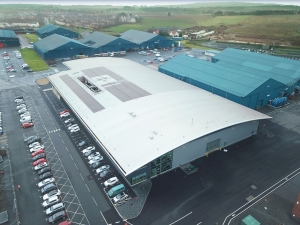
The view from above — the AluPlusSolar system fits perfectly with the Kalzip 65/400
About Kalzip
Kalzip sells and produces aluminium roof facade profiles for the areas of industrial construction, leisure facilities/sports facilities, transport and housing. The Kalzip Group employs 160 people worldwide and is represented in almost all regions of the world. Since October 2018, Kalzip has been a company of the Donges Group. Donges Group is a leading supplier of bridge and steel construction as well as roof and facade systems in Europe. The group consists of the brands Donges SteelTec GmbH, Flachdach- Technologie GmbH & Co. KG, Kalzip GmbH, Nordec OY and Norsilk SAS and employs around 1400 people in 14 countries.
Contact
Kalzip GmbH
Yannick de Beaureagard
August-Horch-Straße 20 — 22
56070 Koblenz
Phone: +49 261 9834 217
Fax: +49 261 9834 100
E-Mail: yannick.de-beauregard@kalzip.com
